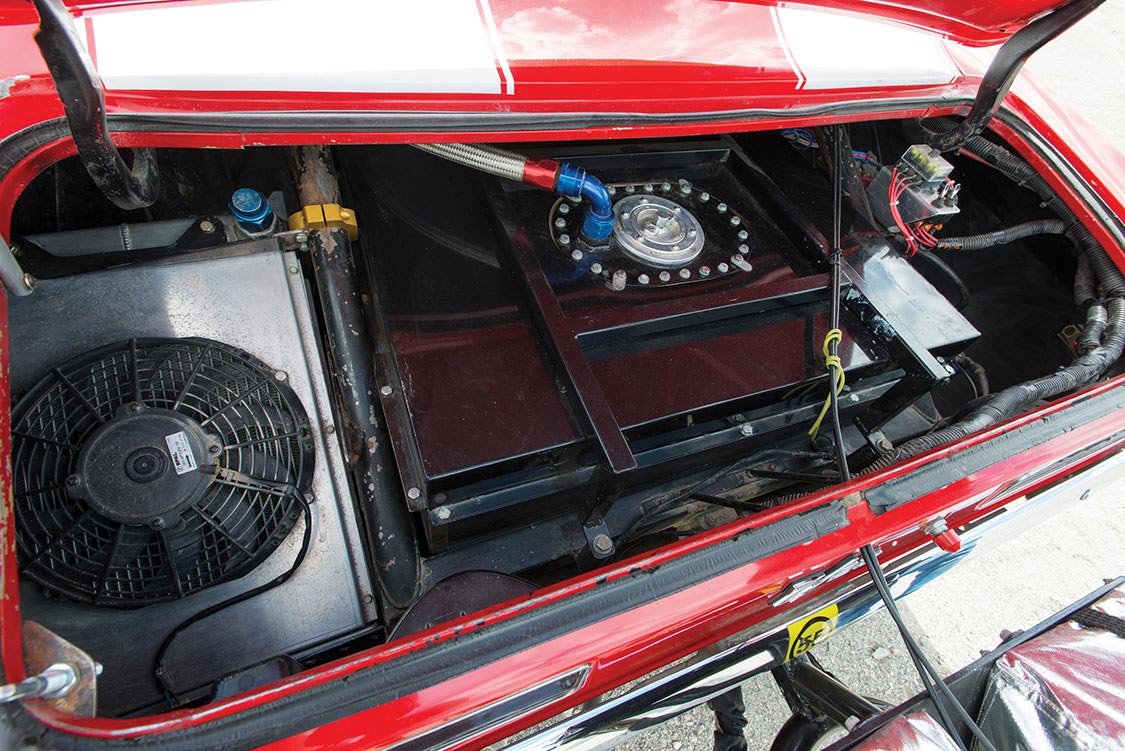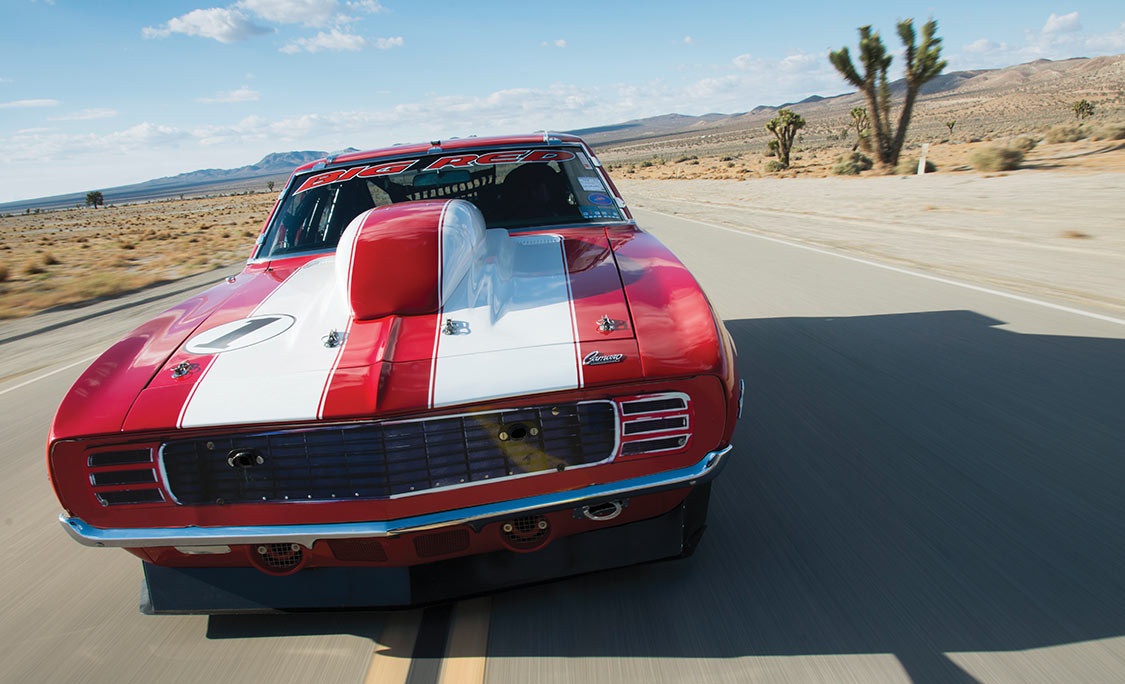Lou Leto November 21, 2022 All Feature Vehicles
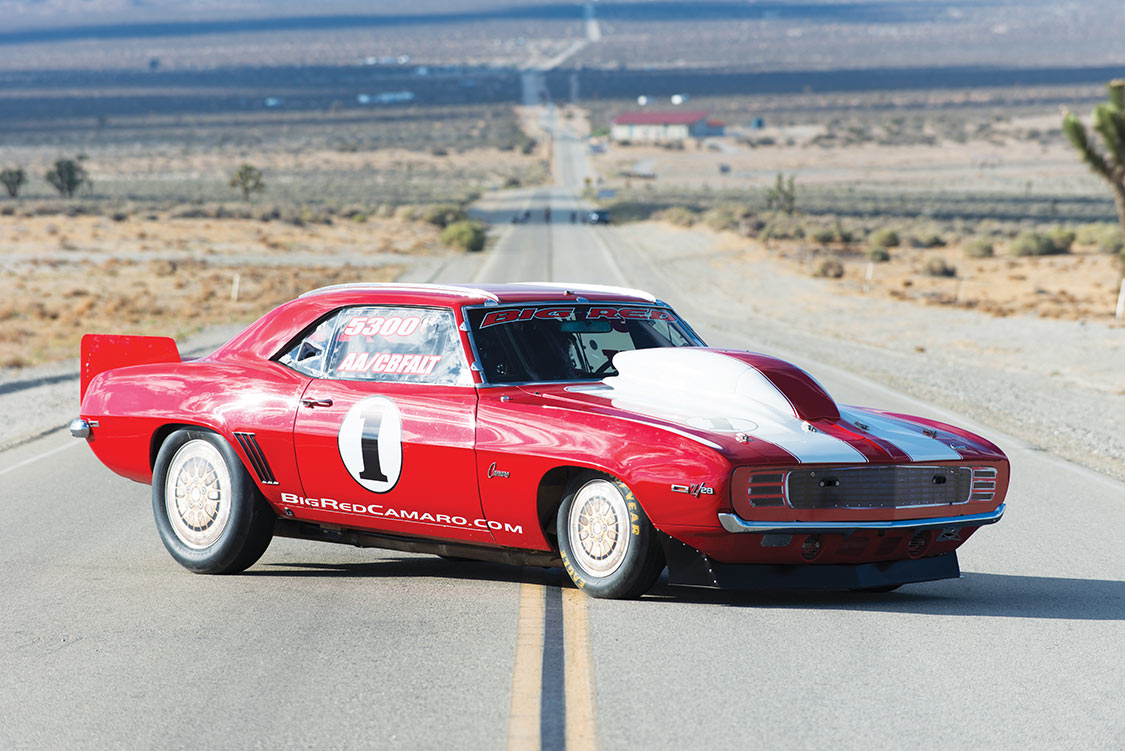
Big Red Camaro, three words that have conjured up emotions for multiple generations of car guys; three words that have set impossible records, and broken them, along with the dreams of owners of more exotic vehicles; three words that evoke awe even as the car sits statically, all hunkered down over its broad, muscular fenders, looking ready to move forward aggressively, loudly and quickly; and finally, three words that intimidate owners, drivers and crews at any road race or high-speed contest. For nearly three decades, Big Red Camaro has had a high-speed appetite, gobbling up asphalt, salt and silt-like dirt all over North America in a quest to be the fastest.
It all started in 1987, when Dan Gottlieb decided he wanted a vehicle for his son RJ to race. Dan and RJ’s quest for top honors was unceasing, but they were equally concerned with safety, which mandated that a full NASCAR-type chassis (built by Bill Osborne), complete with a significant engine setback for better weight transfer, be fabricated underneath and inside a stock-appearing ’69 Camaro.
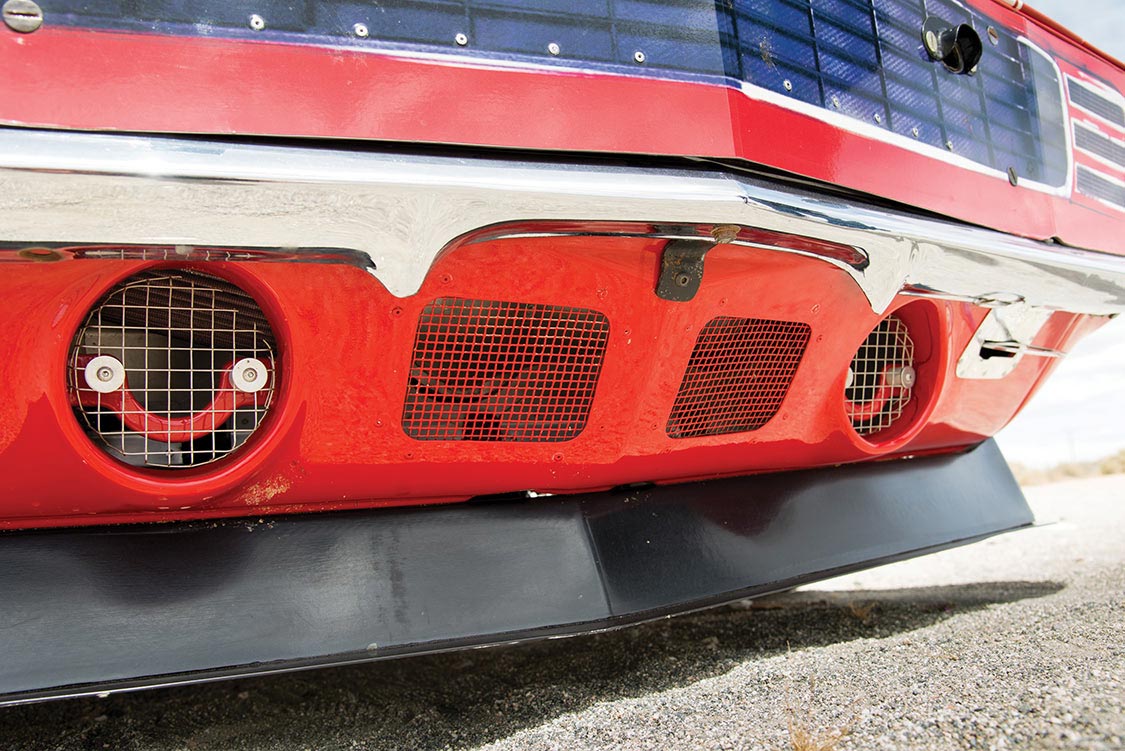
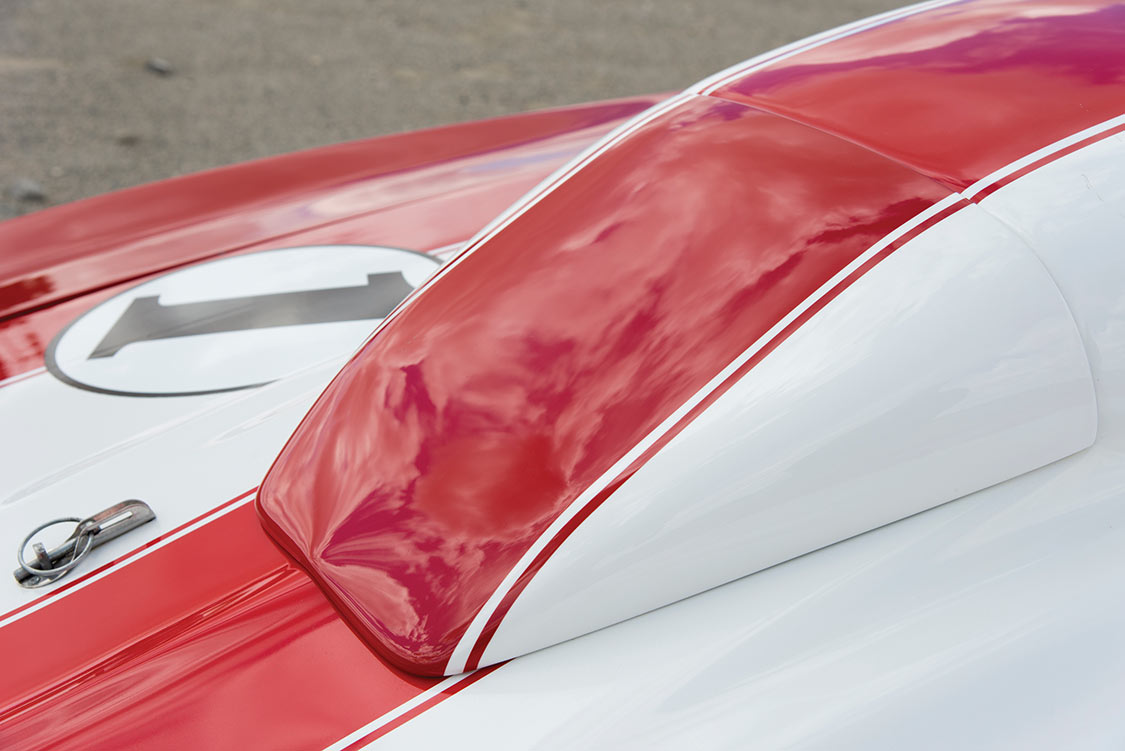
“Given the choice of car, I thought that the ’69 Z/28 with hideaway headlights was the ultimate muscle car. That muscular one-year body style is recognizable to so many fans. Who doesn’t have a ’69 Camaro story they can identify with?” RJ told us. He’s right, of course, as evidenced by the fact that the ’69 was selected by consumers during Chevrolet’s 100th anniversary as their number one favorite Chevy vehicle.
“It was an old car [RJ was born in 1970]. It was just the right shape, looking so American, appearing best in red with white stripes that would stand out in a sea of exotics and European high rollers that are an out-of-reach cost for most race fans,” RJ said. “We went out of our way to maintain that stock-appearing body. While the Camaro of this era is not the best platform to do what we wanted to do, our philosophy was to maintain the basic element of classic American muscle: use a big bore [540 ci] big-block, clearly overpowered V-8 engine,” RJ admitted. Another key element to their philosophy was to do it all without sponsorship.
Big Red annihilated the record for the La Carrera Classica while achieving overall victory, and race organizers gained a new three-word description for the 19-year-old driver: world’s fastest teenager. Coming back in 1989, and defined by the La Carerra organizers as “the outlaw racer,” the Camaro was bold and powerful, but did not finish. In a new adventure that same year, RJ piloted Big Red Camaro through 94 miles of closed-off Nevada roads and mountain passes to average 197.99 mph, reaching an incredible 222-mph top speed. Then, after nine full years of dominating speed events, RJ retired Big Red Camaro in 1996, focusing on earning an MBA, trading the handling of the banking on canyon roads and race tracks for a career in investment banking, and later, establishing a family.
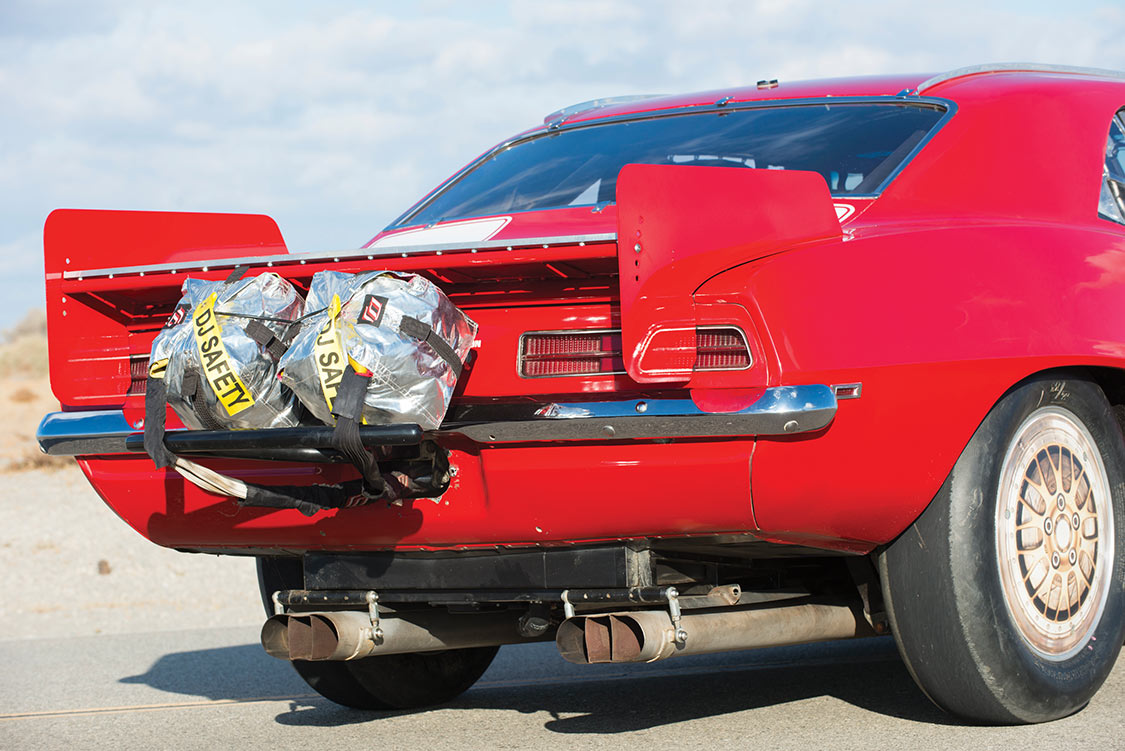
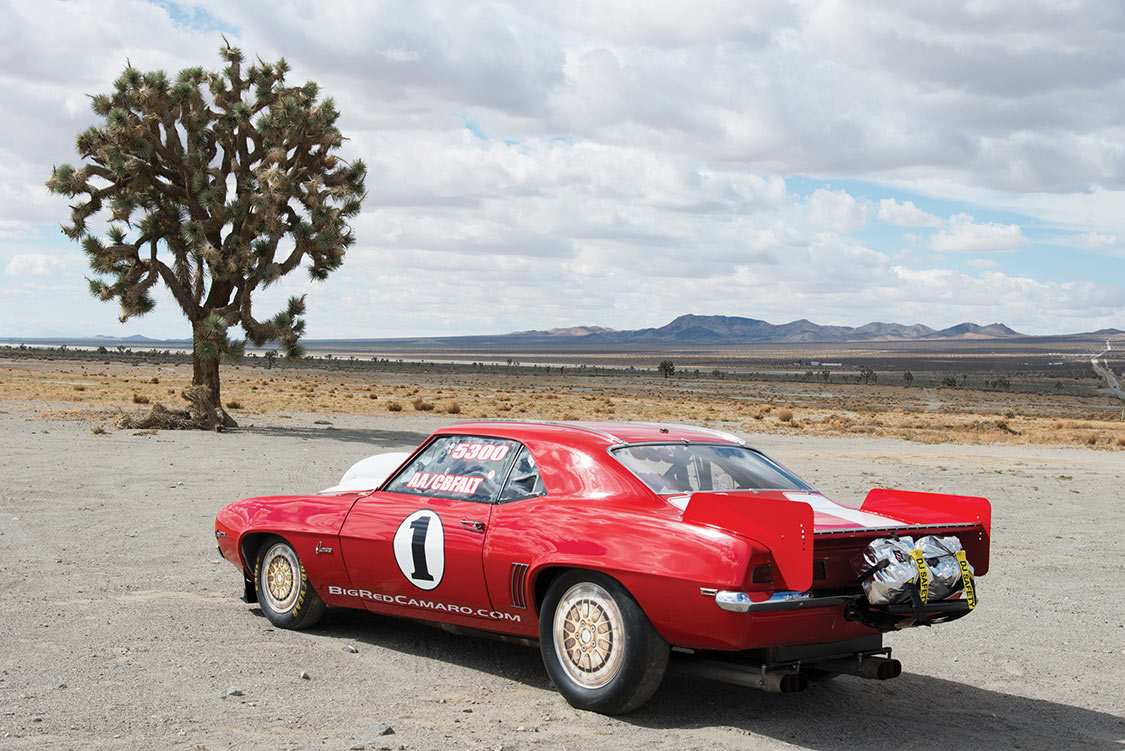
Eight years passed, while the Big Red Camaro sat idly on display, away from its Southern California home base, as an attraction in Laughlin, Nevada, until the lure of the red mist sparked a full restoration and jumpstarted thoughts of going hunting for top speed records again. “I was older. I knew that I didn’t want to be a professional racer. Big Red was a logical place to be—for the purity, excitement and to continue to have fun,” RJ remembered. “There was no specific goal.” A year later, now powered by a 598-ci big-block, the Camaro won more top honors in a 1-mile Z2Z event. In the ensuing years, with other versions of 598s, the car garnered many awards, and even“went Hollywood” with an appearance in Fast and Furious 4.
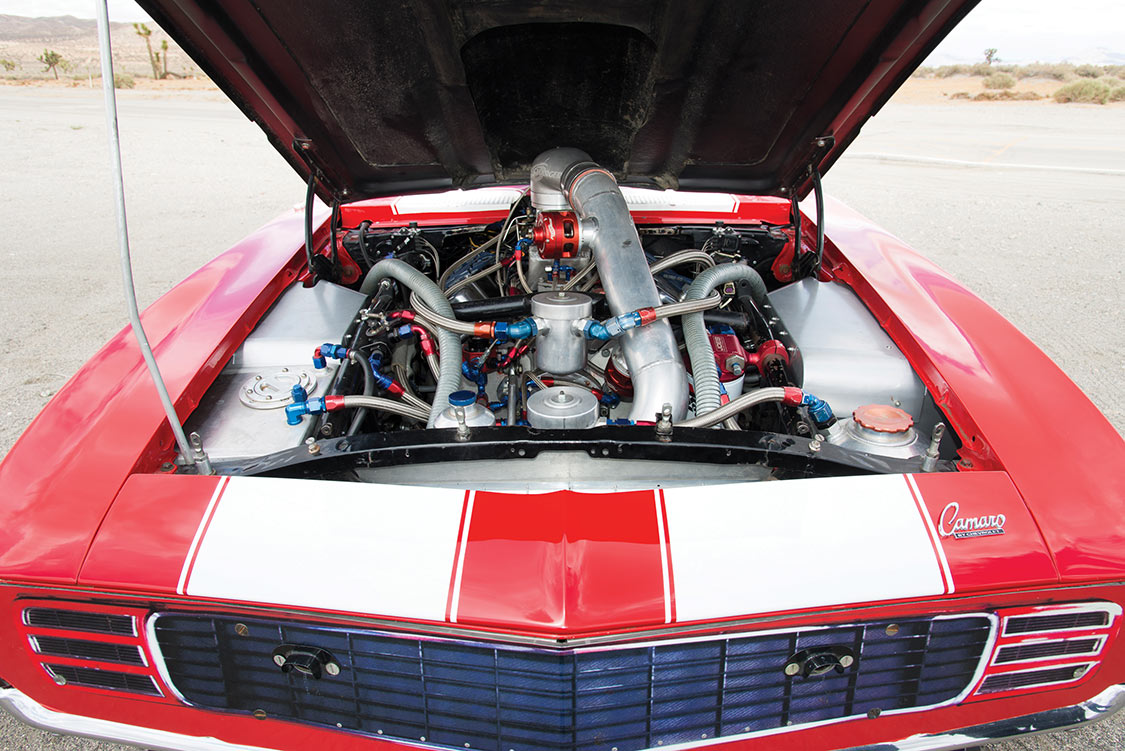
Big Red can also be referred to as a big red chameleon. It had become a multi-purpose racer, alternating between road-racing and land speed venues. Unique setups are required for each, including engine and transmission changeovers, specific rearend ratios and suspension changes. Wheels and tires are swapped for specific events. The battery, fuel cell and radiator are moved around, and for land speed attempts, the front grille is covered with a Lexan flush panel, and the wheels use Moon discs. To painstakingly continue to preserve the stock look of a ’69 Camaro, artwork is used to illustrate the front grille with hideaway headlights on the Lexan blocker panel, and the Dzus-fastened Moon hubcaps have illustrations of the BBS wheels that Big Red wears for road race events. A changeover from straight-line events to road-racing configuration requires three weeks in team manager Dave Ward’s shop, Precision Welding (Hesperia, California); the events calendar is well laid out in advance. Dave’s description of the chassis, fitted with QA1 double adjustable coil-overs, includes selecting massive halting power via 12-inch rotors clamped byWilwood Dynalite brake calipers or 14-inch rotors with Baer brakes. To augment stops after high-speed runs, a DJ Safety parachute system was designed. Since driver safety is paramount, a Diest Safety fire system has been plumbed.
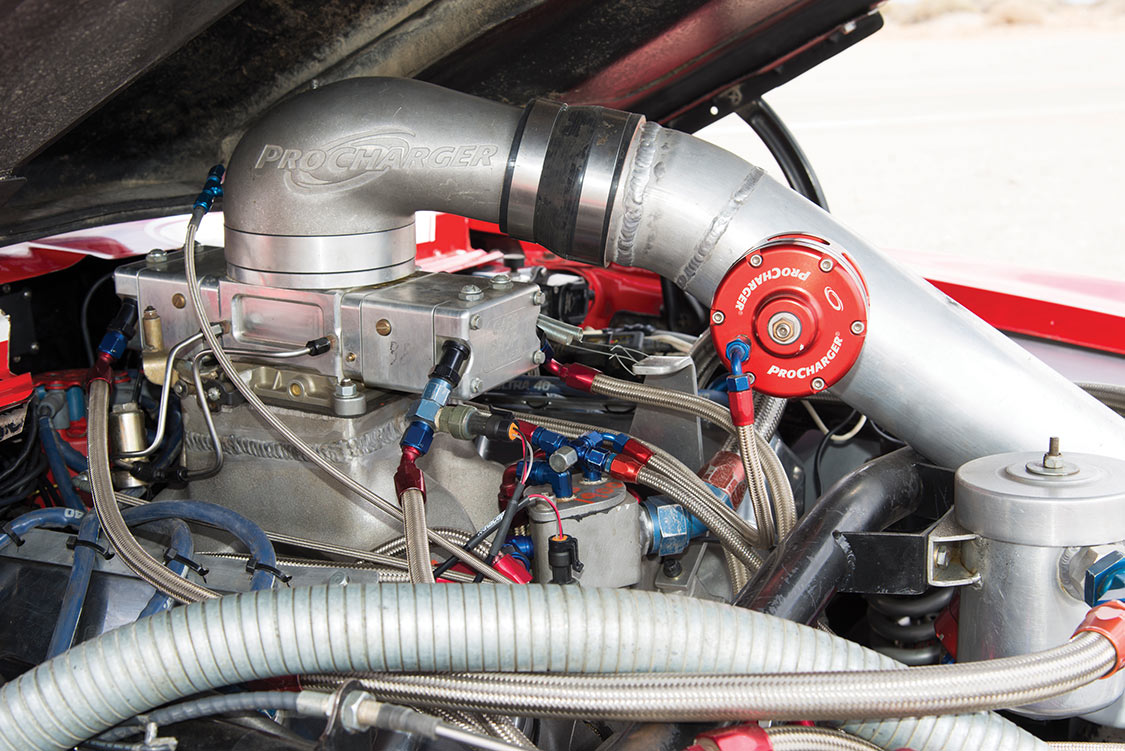
New opportunities that came through the increased popularity of standing mile and standing 11⁄2-mile events captured the team’s interest. In 2012, the car clocked 234.4 mph at the Mojave Magnum, and the lure of driving on the salt flats at Bonneville became too much to resist. Big Red Camaro got a blower addition and a ProCharger supercharger to significantly up the horsepower. There was no magic formula, and the team had teething problems as it learned and adapted to the challenges of pushing this brute across five miles of low-traction surface.
Land speed racing at Bonneville always has its particular challenges. In addition to trying to dial in blower pressures, various types of octane, ignition timing, weight distribution or choosing tire profiles and diameters, local weather is an uncontrollable factor. Wind can blow out a day. Long-term winter weather can cause an unacceptable water level on the salt that can literally throw a wet blanket on an entire week of sanctioned racing that may have been planned a year in advance, and so it went. Later in the season, an invitation to participate in Mike Cook’s Shoot Out at Bonneville provided sorting-out time for the cooling and ignition gremlins that rose up from 5-mile-long land speed attempts. “We tasked the Larry Mollicone-built engines to run wide open at 7,000 rpm with significant high horsepower for long distances,” RJ reminded us. Mollicone has built every engine for Big Red since the beginning.
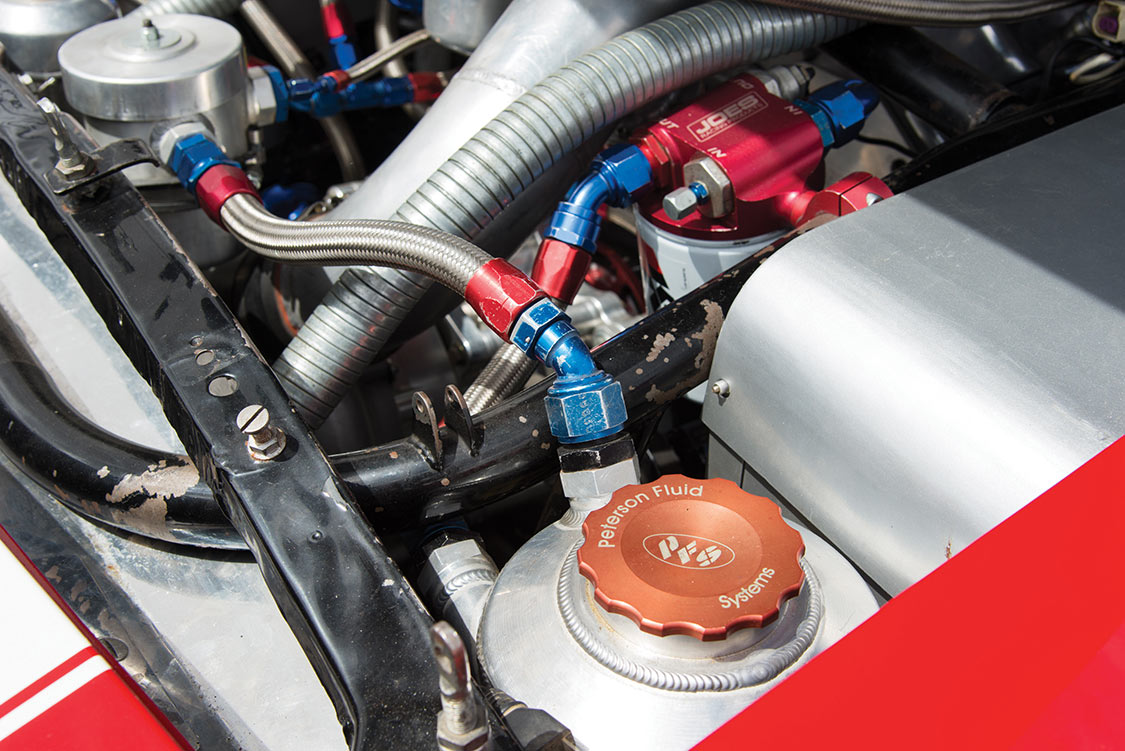
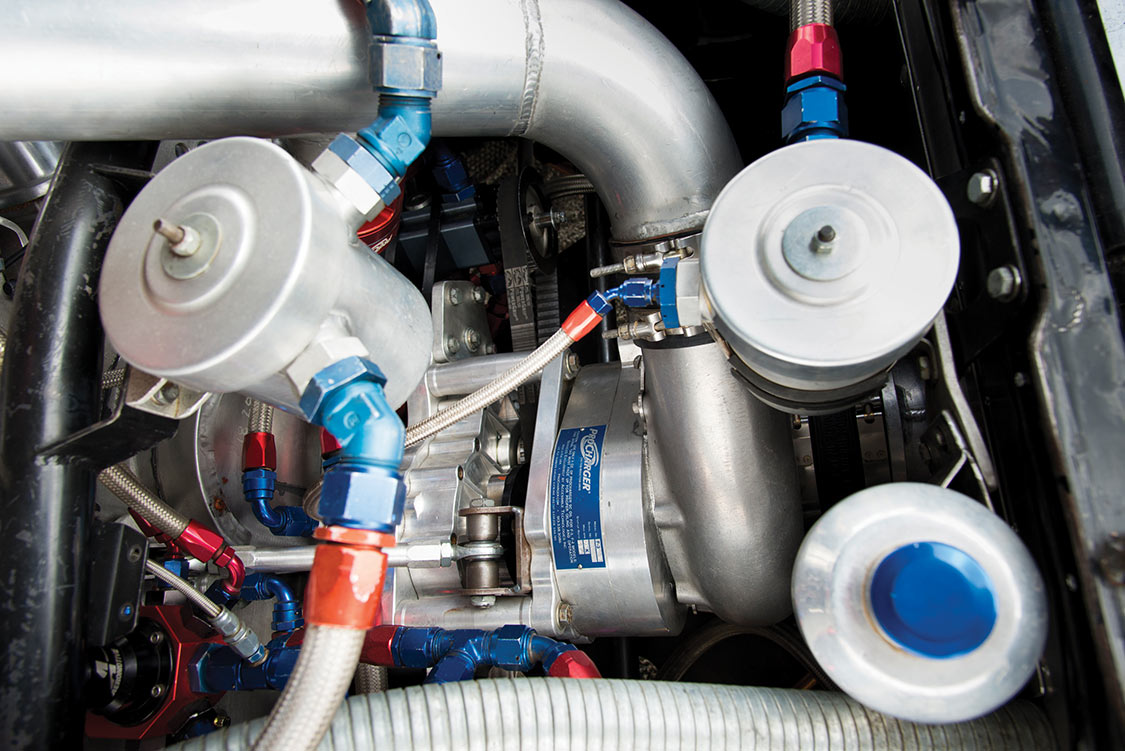
Similar challenges occurred at the other famed land speed racing location, El Mirage. The silt surface denies traction, while creating a fine, powdery, very dirty environment that ensures every internal and external surface is invaded and coated. By three-quarter track during high-speed test runs, RJ was literally blinded by the dirt, “We had to figure out how to pressurize the cockpit,” Dave admitted.
Now we arrive at year 2015, and the team was back at Mojave for the Magnum. Equipped with a new MAP sensor, the crew achieved 235- and 238-mph runs. The Camaro is a 47-year-old, stock-bodied car that continues to set the bar, having defeated all comers in the Unlimited Class. It’s an unbiased, equal opportunity form of humbling new vehicles with exotic technologies.
Throughout the history of Big Red, the attitude of “there is no substitute for cubic inches” has always been its fans’ philosophy. It’s a sentiment that’s confirmed on the website, Bigredcamaro.com, where the earliest, a 540-ci engine, is referred to as a “Peanut motor” with only 850 hp. The latest three versions, which start at 990 hp and move up all the way up to 1,900, are all identified with the basic architecture of 598 cubes, with purpose-built Brodix cylinder blocks, heads and intake manifold.
Unique racing applications are considered when assembling for specific forms of speed and/or endurance. Focusing on the latest 598 engine, developed for land speed attempts, the selected components include a crank supplied by Kings Crankshaft, with Diamond pistons tied to Carrillo connecting rods. The camshaft is sourced from Bullet. Keeping the lubrication flowing is a Stock Car Products oil pump; the oil pan is an Olsen unit. Fuel delivery is through a Ron’s Fuel Injection mechanical fuel pump. MSD supplies the ignition and distributes the spark to the fuel/air mixture. Exhaust gases are expelled through headers built by Arizona-based REM. Racing fuels are from VP, and all fluids and air are filtered by Moroso.
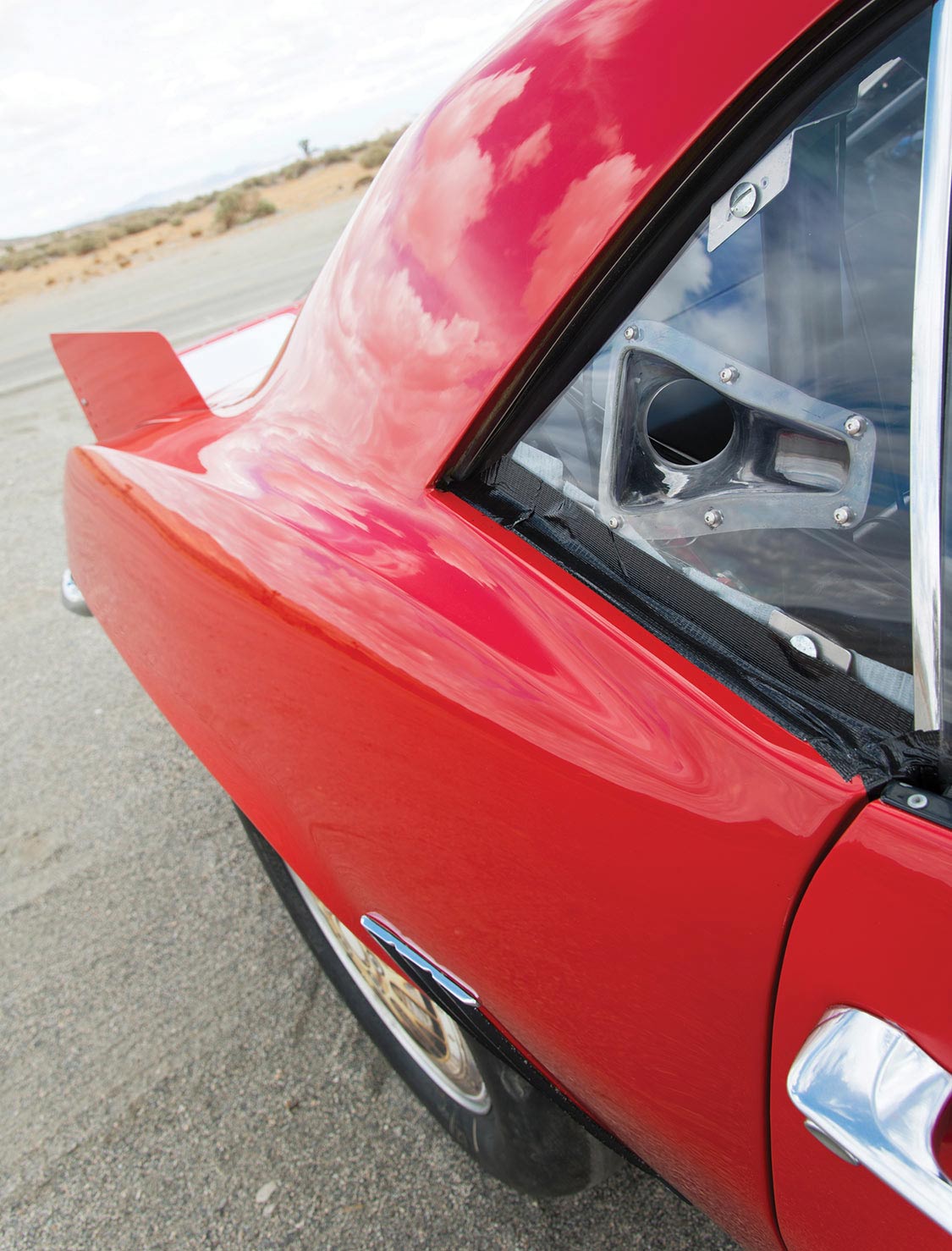
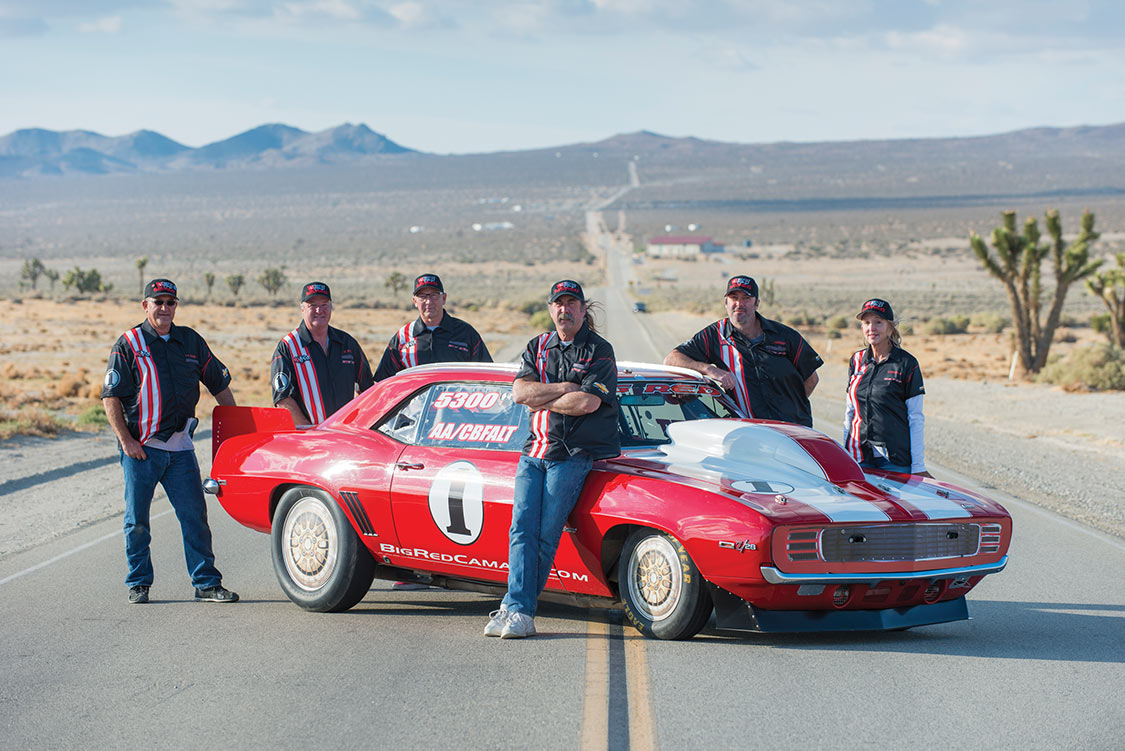
The key high-horsepower element also offers powerful visual impact: a front-mounted ProCharger supercharger, with its huge plumbing, up to the Carb Shop-engineered blow-through carburetor. “In most supercharger applications, the ProCharger would be belt-driven, but the low-traction surfaces of land speed racing cause a lot of on/off throttle activity; this could snap any belt,” Dave explained. “We chose a gear- driven supercharger drive system engineered by Alston Chassis Works. The added benefit is that we can change gears in the drive, allowing the team to vary the boost.” Those gear changes can increase boost that allows the team a horsepower range of 1,400-1,900. The trunk-shaped, large-diameter plumbing from the ProCharger to the carb triggered the nickname of this new land speed engine, “The Elephant.”
Big Red didn’t just happen. It takes a commitment to excellence and results that only comes from the experience that a long-term, supportive crew can offer. As team manager, Dave is fortunate to have Tim Fleenor as crew chief. Head mechanic Mark Ewing works with his talented team of mechanics: Shawn Umphries, Eddie Cummins and Cliff Whetstone. Lorna Ward is the team’s event coordinator, and Larry Mollicone, as we mentioned earlier, has built every engine for Big Red since the beginning. Whether road racing or blasting down a straight line, monitoring is critical and essential; Racepak diagnostics and tech are handled by Zach Smith. Dan Gottlieb, the man with the plan to get RJ racing way back when, still owns Big Red. RJ has been the sole driver behind the wheel.
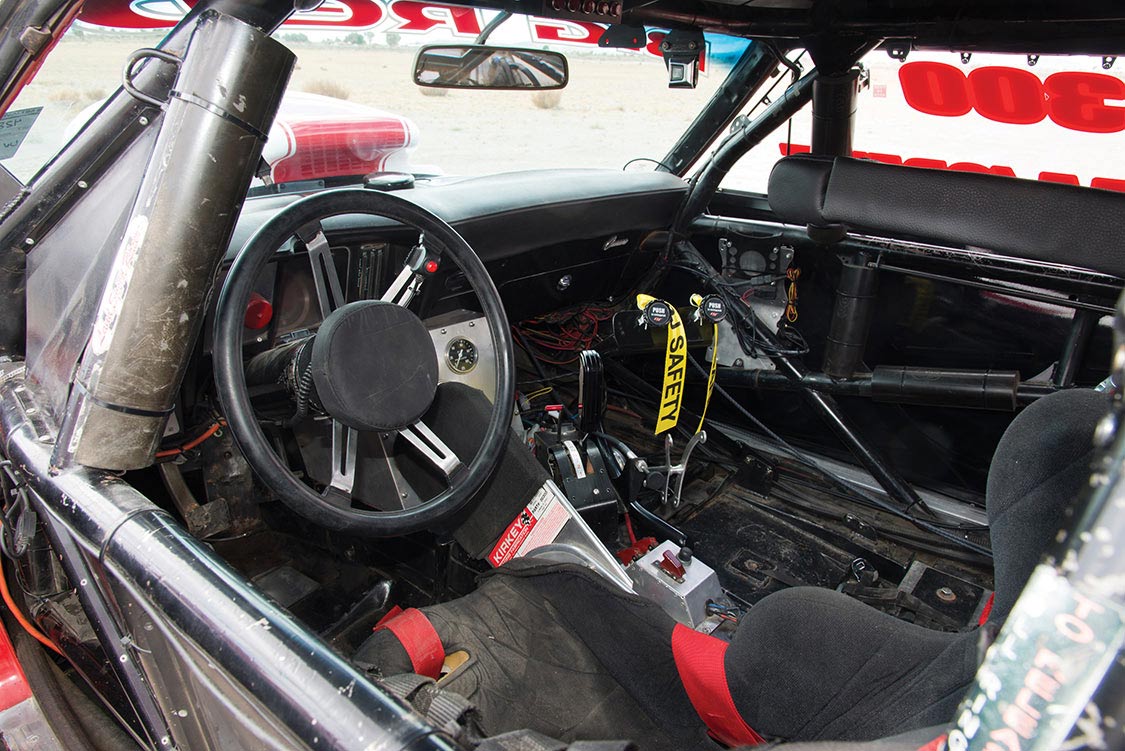
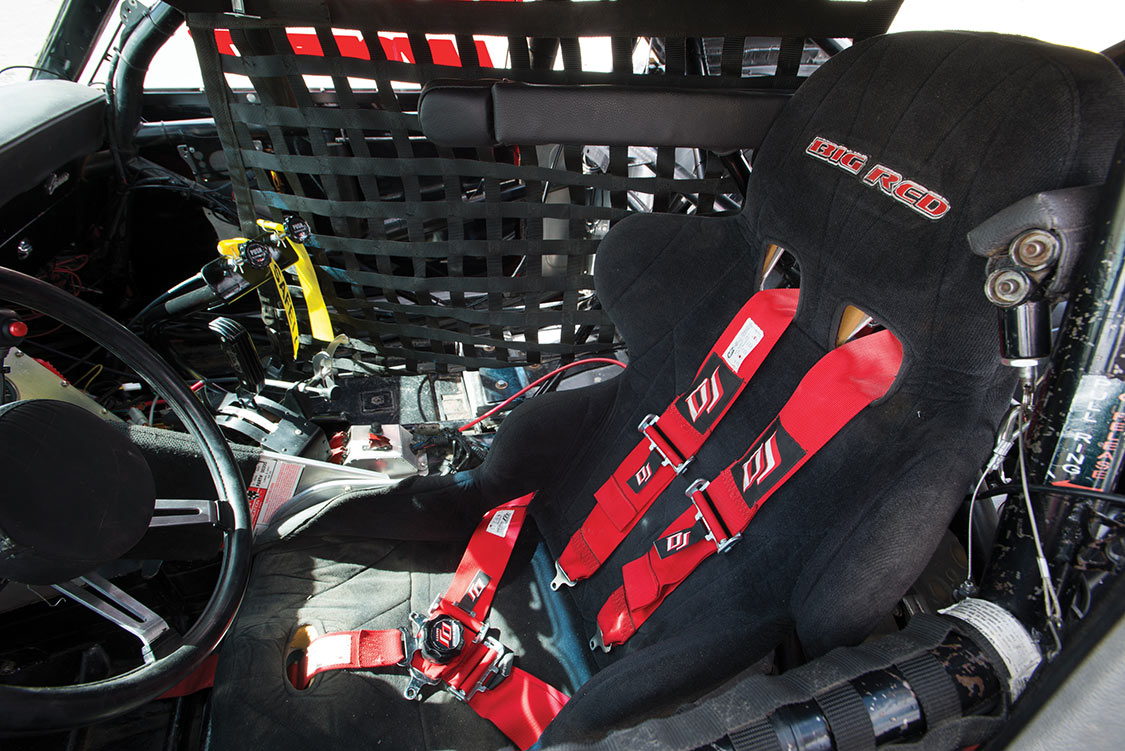
Big Red has earned its reputation more as a Camaro than for driver RJ, and he’s comfortable with that. “When I stand near the car, people make the connection from the old photographs of the red-haired teenaged driver with Big Red. If I step away, or am walking around without my driving suit, I am not recognized.” RJ said. As with many legends, history can be distorted. The accurate story of this iconic Camaro was also told through Big Red, the Original Outlaw Racer, on NBCSN. Big Red Camaro remain three monumental words in automotive and racing history. The legend lives.
